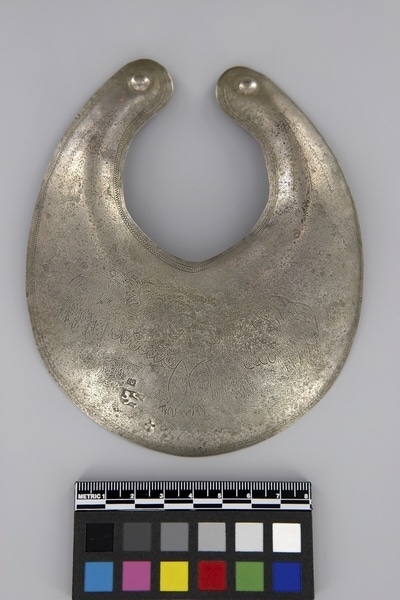Gorget Item Number: 1590/256 from the MOA: University of British Columbia

Description
Crescent-shaped convex gorget. Engraved eagle with wings spread. Border of zigzag line within double lines. Two holes at top. Maker’s mark stamped beside eagle’s claws.
History Of Use
In Europe during the Renaissance period the helmets of warriors were fitted with a crescent-shaped plate called a gorget, which extended downward to protect the throat. Gradually, this armour became obsolete due to the use of firearms, but some breastplates, helmets and gorgets were brought to North America for protection against native arrows. The use of this armour declined here too, in favour of increased mobility, but the crescent-shaped gorgets continued to be worn separately by officers as a badge of military rank and authority, and consequently had appeal as trade items denoting strength and power. Reference Hamilton, pages 69-71.
Silver ornaments represent an important part of early exchange between Europeans, including fur traders, and First Nations peoples, especially in eastern and central Canada and the U.S.A. Initially, the main source of silver was British, French and Spanish coins. Most ornaments were produced by silversmiths of European origin in North America and Europe, and were actively traded only from 1760 to 1821. By the mid-18th century silver objects were produced in New England, Quebec and Montreal. Silver was used by First Nations peoples as a sign of rank. Silver ornaments in these styles continue to be produced by native silversmiths in central Canada and the U.S.A.
Specific Techniques
Rocker engraving is a freehand technique. Irregularity is characteristic.
Cultural Context
trade; personal decoration; status
Item History
- Made by Louis Jackson (Manufacturer) in Montreal, Quebec, Canada between 1760 and 1821
- Owned by Kathleen E. Reif before September 9, 1993
- Received from Kathleen E. Reif (Donor) on September 9, 1993
What
Who
- Culture
- Eastern Woodlands
- Creator
- Louis Jackson (Manufacturer)
- Previous Owner
- Kathleen E. Reif
- Received from
- Kathleen E. Reif (Donor)
Where
- Holding Institution
- MOA: University of British Columbia
- Made in
- Montreal, Quebec, Canada
When
- Creation Date
- between 1760 and 1821
- Ownership Date
- before September 9, 1993
- Acquisition Date
- on September 9, 1993
Other
- Item Classes
- metalwork
- Condition
- good
- Accession Number
- 1590/0256